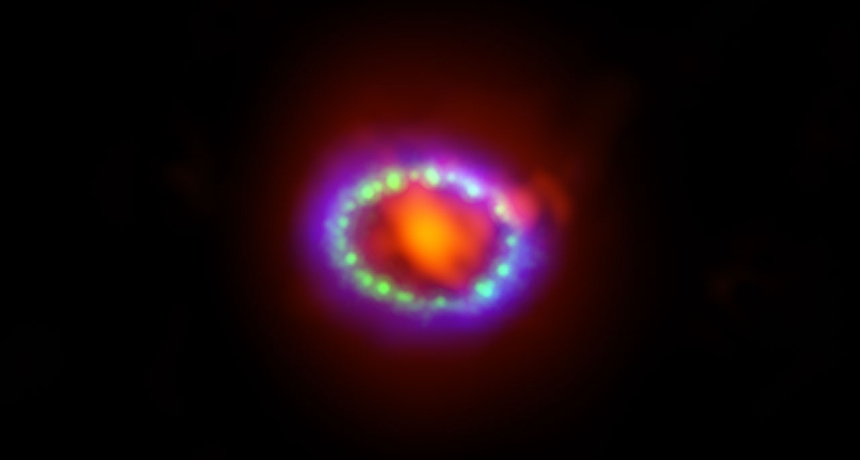Dusty remains from a dead star
A glowing cloud of dust spotted near a supernova offers clues to how the earliest stars formed

This is Supernova 1987A, an exploding star that first became visible in February 1987. Astronomers combined images taken with three different telescopes to produce this one. Dust in the center of the debris shows up as red. Scientists say supernovas like this one may have been responsible for spewing dust in the universe and boosting the formation of early stars.
ALMA/ESA; HUBBLE/NASA AND ESA; CHANDRA/NASA
A distant cloud of space dust is helping scientists confirm how stars likely formed in the early universe. They had thought new suns formed from the dusty debris ejected as old stars died. But until now, they had never gotten a good look at that dusty residue in the vicinity of a massive dying star.
When a massive star runs out of fuel, it grows brighter and explodes, creating what’s called a supernova. Astronomers have been trying to measure the huge amounts of dust spewed by a supernova. They made their best measurement to date in a recent study of a supernova first seen 27 years ago in a nearby galaxy. Remy Indebetouw of the University of Virginia in Charlottesville and his coworkers studied it using powerful telescopes high in the mountains of Chile.
On Jan. 6, at a meeting of the American Astronomical Society outside Washington, D.C., they reported finding dust littering the supernova’s vicinity. This dust “had to have been made there,” Indebetouw told Science News. And there was lots of dust. His team’s measurements now suggest that collectively, the mass of this remnant dust is about equal to one-fourth of the mass of our sun. That measurement is in line with a 2011 study on the dust that used data from a less powerful telescope.
The universe is littered with dust. It differs from the dirty stuff that gathers on dressers and hides under couches. Stardust consists of grains of elements like carbon, oxygen and silicon. And all but the very earliest stars have been built from such dust. Or at least that’s what astronomers had assumed.
The problem: No one had ever definitively linked the dust to its supernova source. The new measurement helps confirm that supernovas have helped to scatter dust throughout the universe. When enough dust ends up in the same region, gravity can pull it together, creating the seeds of matter needed to build a new sun.
Scientists had witnessed dust in the neighborhood of big, old stars. And it made sense that supernovas would produce the stuff. During their violent explosions, the superhot material that had been in or near the star can cool to hundreds of degrees below zero — all within a few years. That cooling process forms the grains of matter that astronomers describe as space dust.
Yet astronomers never had the chance to study supernova dust until a star 168,000 light-years away exploded so brightly that it could be seen from Earth. (A light-year is the distance light travels in a year.) That supernova first appeared in the night sky in February 1987 and remained bright until May. Scientists have been studying the remnants of this dying star, known as 1987A, ever since.
Spying its dust helps astronomers sketch out what happened in the early universe. Previous telescope observations had shown that individual galaxies carry around a lot of dust. That dust might contain as much mass as hundreds of millions of stars the size of our sun. Scientists didn’t know the source of all of that dust. Although they suspected the powerful force of a supernova might have helped propel that dust far and wide, telescopes hadn’t turned it up in the vicinity of new supernovas.
Devin Silvia is an astrophysicist, or an astronomer who uses physics to better understand stars. He works at Michigan State University in East Lansing. “We had wondered why we didn’t see the dust,” he told Science News. Still, scientists had expected it to be there. “That’s what makes this such a huge deal.”
The case isn’t closed on supernova dust. In the next century, much of 1987A’s dust might get destroyed by waves of heat from the supernova. If that happens, it will show that supernovas might not be able to eject dust very far into the universe. Luckily, scientists won’t have to wait too long to learn more. They can keep an eye out for other distant supernovas, and more signs of dust.
Power Words
astronomy The area of science that deals with celestial objects, space and the physical universe as a whole. People who work in this field are called astronomers.
astrophysics An area of astronomy that deals with understanding the physical nature of stars and other objects in space.
galaxy A massive group of stars bound together by gravity. Galaxies, which each typically include between 10 million and 100 trillion stars, also include clouds of gas, dust and the remnants of exploded stars.
light-year The distance light travels in a year in a vacuum, nearly 9.5 trillion kilometers (or nearly 6 trillion miles).
supernova (plural: supernovae or supernovas) A massive star that suddenly increases greatly in brightness because of a catastrophic explosion that ejects most of its mass.
supernova remnant The clouds of gas and debris surrounding a star that exploded long ago. The strong magnetic fields inside these remnants accelerate protons to very high speed, creating cosmic rays.







